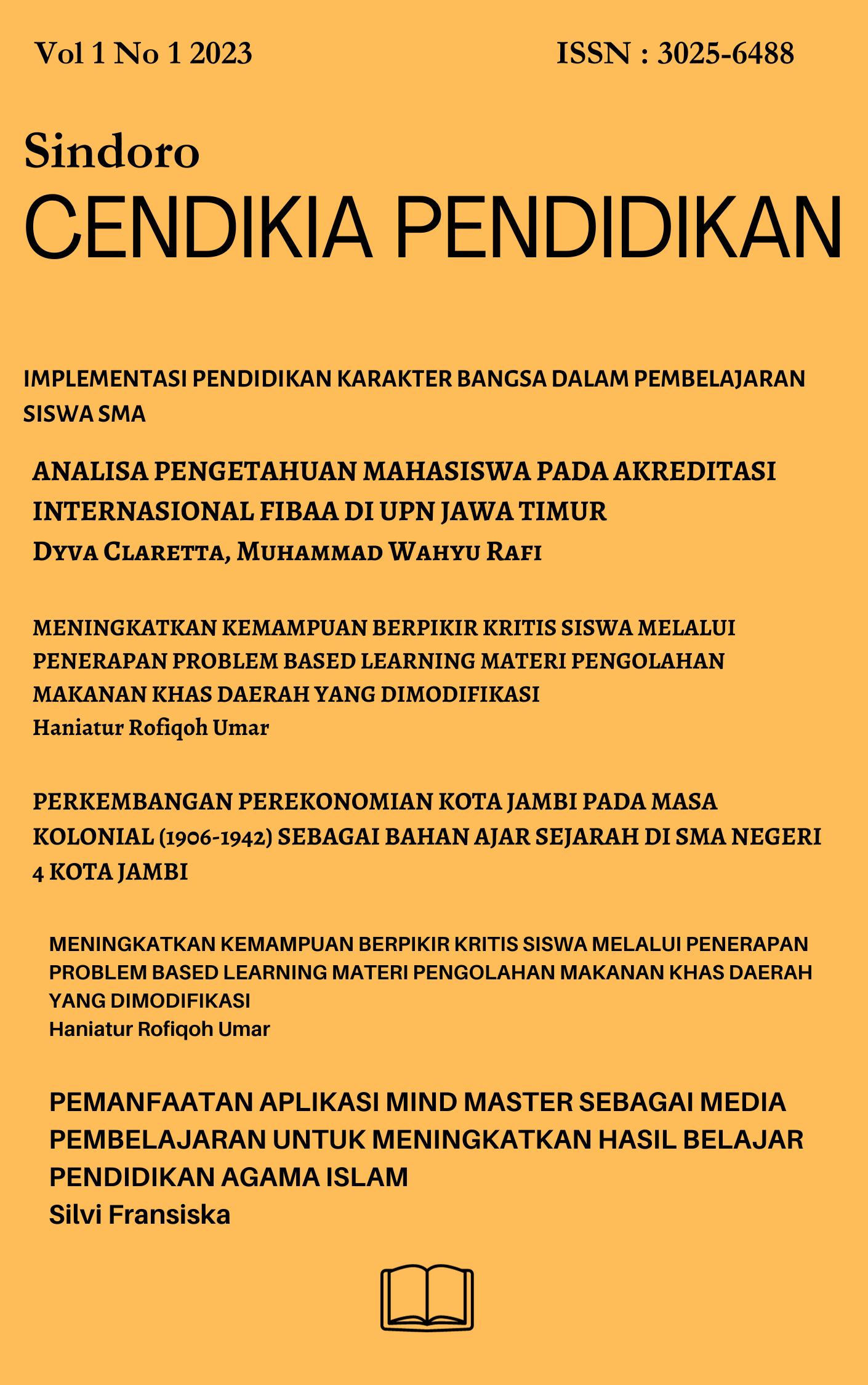PENGEMBANGAN MEDIA PEMBELAJARAN KEARSIPAN DIGITAL BERBASIS WEBSITE
Main Article Content
Abstract
This research aims to: (1) develop a web-based archives learning media, (2) determine the feasibility of Arsip Teladan as a web-based archives learning media, (3) describe and explain the usefulness of the Arsip Teladan application for users, (4) as a guide for using the Arsip Teladan application. The type of research used is research and development (RnD) using the ADDIE development method (Analysis, Design, Development, Implementation, Evaluation). This research only reached the development stage by testing the feasibility of Arsip Teladan as a archives learning media validated by media experts and material experts. Data collection techniques were carried out by means of observation and questionnaires. Data analysis was carried out with qualitative and quantitative analysis. Based on the research that has been done, the researcher gets the following results: (1) Arsip Teladan as a website-based archives learning media has been developed with the address https://s.id/ArsipTeladan, (2) based on the results of expert validation, it is known that Arsip Teladan is suitable for use with the results of the average score of media expert validation 97% with the category “Very Feasible” and the average score of material experts 97,1% with the category “Very Feasible” as learning media.
Article Details

This work is licensed under a Creative Commons Attribution-NonCommercial 4.0 International License.
This work is licensed under a Creative Commons Attribution-ShareAlike 4.0 International License.
Authors who publish with this journal agree to the following terms:
- Authors retain copyright and grant the journal right of first publication with the work simultaneously licensed under a Creative Commons Attribution License that allows others to share the work with an acknowledgement of the work's authorship and initial publication in this journal.
- Authors are able to enter into separate, additional contractual arrangements for the non-exclusive distribution of the journal's published version of the work (e.g., post it to an institutional repository or publish it in a book), with an acknowledgement of its initial publication in this journal.
- Authors are permitted and encouraged to post their work online (e.g., in institutional repositories or on their website) prior to and during the submission process, as it can lead to productive exchanges, as well as earlier and greater citation of published work
References
Akdon, & Ridwan. (2013). Rumus dan Data dalam Aplikasi Statistika. Bandung: Alfabeta.
Anita. (2022). Digitalisasi dan Ketimpangan Pendidikan: Studi Kasus terhadap Guru Sekolah Dasar di Kecamatan Baraka. Junal Pendidikan dan Kebudayaan.
APJII Jumlah Pengguna Internet Indonesia Tembus 221 Juta Orang. (2024, Februari 07). Retrieved from Asosiasi Penyelenggara Jasa Internet Indonesia (APJII): https://apjii.or.id/berita/d/apjii-jumlah-pengguna-internet-indonesia-tembus-221-juta-orang
Basak, S. K., Wotto, M., & Belanger, P. (2018). E-learning, M-learning and D-learning: Conceptual Definition and Comparative Analysis. SAGE.
Chusna, N. L. (2019). Pembelajaran E-Learning. Prosiding Seminar Nasional Pendidikan KALUNI.
Digital 2024: 5 billion social media users. (2024, Januari 31). Retrieved from we are social: https://wearesocial.com/id/blog/2024/01/digital-2024-5-billion-social-media-users/
Elisa, H., Marganingsih, A., Beding, V. O., Sijono, & Aristo, T. J. (2022). Penggunaan Aplikasi Appsheet sebagai Media Presensi Online Selama Aktivitas Pembelajaran Daring. ARSY: Aplikasi Riset kepada Masyarakat.
Endang, S., Mulyani, S., & Suyetty. (2018). Kearsipan. Jakarta: Penerbit Erlangga.
Fadillah, N., Pratama, A., & Febriantina, S. (2021). Pengembangan Desain Pelatihan Penggunaan Digital Learning Platform Bagi Mahasiswa Bidang Pendidikan. Jurnal Ilmiah Wahana Pendidikan.
Herlina, V. (2019). Panduan Praktis Mengolah Data Kuesioner Menggunakan SPSS. Jakarta: Elex Media Komputindo.
Kholid, S. F. (2019). Penerapan E-Learning Kelasjodoh sebagai Alternatif Pendidikan Pra Nikah. IJACE: Indonesian Journal of Adult and Community Education.
Lee, W. W., & Owens, D. L. (2004). Multimedia-based Instructional Design: Computer-based Training, Web-based Training, Distance Broadcast Training, Performance-based Solutions. San Francisco: John Wiley & Sons.
Nurrita, T. (2018). Pengembangan Media Pembelajaran Untuk Meningkatkan Hasil Belajar Siswa. MISYKAT: Jurnal Ilmu-ilmu Al-Quran, Hadist, Syari'ah dan Tarbiyah.
Oktaviana, S., Kurniawati, L., Putri, S. A., & Utami, L. A. (2023). Pelatihan Penggunaan AppSheet Untuk Pengelolaan Arsip Digital Organisasi di JPRMI DKI. Jurnal Pengabdian Kolaborasi dan Inovasi IPTEKS.
Olson, M. H., & Ramirez, J. J. (2020). What is Learning? In An Introduction to Theories of Learning. Routledge.
Ormrod, J. E. (2017). How We Think and Learn: Theoretical Perspectives and Practical Implications. New York: Cambridge University Press.
Patresia, P., Wali, M., & Imilda. (2022). Absensi Online Berbasis Android (Implementasi Platform Appsheet). Jurnal Indonesia: Manajemen Informatika dan Komunikasi.
Peprizal, & Syah, N. (2020). Pengembangan Media Pembelajaran Berbasis WEB pada Mata Pelajaran Instalasi Penerangan Listrik. Jurnal Ilmiah Pendidikan dan Pembelajaran.
Purba, H. S., Drajat, M., & Mahardika, A. I. (2021). Pengembangan Media Pembelajaran Interakti Berbasis Web Pada Materi Fungsi Kuadrat Kelas IX dengan Metode Drill and Practice. EDU-MAT: Jurnal Pendidikan Matematika.
Ramdani, R. (2018). Media Pembelajaran E-Learning dalam Pembelajaran Pendidikan Agama Islam di SMA Laboratorium Percontohan UPI Bandung. TARBAWY: Indonesian Journal of Islamic Education.
Sajiatmojo, A. (2021). Penggunaan E-Learning Pada Proses Pembelajaran Daring. Teaching: Jurnal Inovasi Keguruan dan Ilmu Pendidikan.
Sartono. (2017). Pengembangan Multimedia Pembelajaran Interaktif Tema Organ Tubuh Manusia dan Hewan untuk Kelas V Sekolah Dasar. Jurnal Ideguru.
Sati, Setiana, D., & Amelia, A. N. (2022). Implementasi Pembelajaran E-Learning terhadap Minat Belajar Peserta Didik di Masa Pandemi Covid-19. Jurnal Basicedu.
Sugihartini, N., & Yudiana, K. (2018). ADDIE sebagai Model Pengembangan Media Instruksional Edukatif (MIE) Mata Kuliah Kurikulum dan Pengajaran. Jurnal Pendidikan Teknologi dan Kejuruan.
Sugiyono. (2017). Metode Penelitian Kuantitatif, Kualitatif, dan R&D. Bandung: Alfabeta.
Sukanto, D. (2020). Pembelajaran Jarak Jauh dengan Media E-Learning sebagai Solusi Pembelajaran pada Masa Pandemi Coronavirus Disease 2019 (Covid-19). Syntax Idea.
Sumiharsono, R., & Hasanah, H. (2017). Media Pembelajaran: Buku Bacaan Wajib Dosen, Guru dan Calon Pendidik. Pustaka Abadi.
Surahman, E., Santaria, R., & Setiawan, E. I. (2020). Tantangan Pembelajaran Daring di Indonesia. Kelola: Journal of Islamic Education Management.
Tambunan, M. A., & Siagian, P. (2022). Pengembangan Media Pembelajaran Interaktif Berbasis Website (Google Sites) pada Materi Fungsi Di SMA Negeri 15 Medan. Humantech: Jurnal Ilmiah Multidisiplin Indonesia.
Utomo, A. P., Amalia, T. R., Iqbal, M., & Narulita, E. (2020). Android-Based Comic Of Biotechnology For Senior High School Students. International Journal of Scientific & Technology Research.
Yaumi, M. (2018). Media & Teknologi Pembelajaran. Jakarta: Prenadamedia Group.

